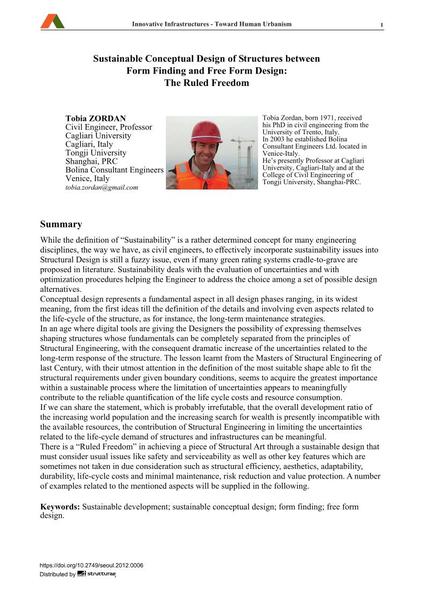Sustainable Conceptual Design of Structures between Form Finding and Free Form Design: The Ruled Freedom

|
|
|||||||||||
Détails bibliographiques
| Auteur(s): |
Tobia Zordan
(Civil Engineer, Professor, Cagliari University, Cagliari, Italy; Tongji University, Shanghai, PRC; Bolina Consultant Engineers, Venice, Italy)
|
||||
|---|---|---|---|---|---|
| Médium: | papier de conférence | ||||
| Langue(s): | anglais | ||||
| Conférence: | 18th IABSE Congress: Innovative Infrastructures – Towards Human Urbanism, Seoul, Korea, 19-21 September 2012 | ||||
| Publié dans: | IABSE Congress Seoul 2012 | ||||
|
|||||
| Page(s): | 6-28 | ||||
| Nombre total de pages (du PDF): | 23 | ||||
| DOI: | 10.2749/seoul.2012.0006 | ||||
| Abstrait: |
While the definition of “Sustainability” is a rather determined concept for many engineering disciplines, the way we have, as civil engineers, to effectively incorporate sustainability issues into Structural Design is still a fuzzy issue, even if many green rating systems cradle-to-grave are proposed in literature. Sustainability deals with the evaluation of uncertainties and with optimization procedures helping the Engineer to address the choice among a set of possible design alternatives. Conceptual design represents a fundamental aspect in all design phases ranging, in its widest meaning, from the first ideas till the definition of the details and involving even aspects related to the life-cycle of the structure, as for instance, the long-term maintenance strategies. In an age where digital tools are giving the Designers the possibility of expressing themselves shaping structures whose fundamentals can be completely separated from the principles of Structural Engineering, with the consequent dramatic increase of the uncertainties related to the long-term response of the structure. The lesson learnt from the Masters of Structural Engineering of last Century, with their utmost attention in the definition of the most suitable shape able to fit the structural requirements under given boundary conditions, seems to acquire the greatest importance within a sustainable process where the limitation of uncertainties appears to meaningfully contribute to the reliable quantification of the life cycle costs and resource consumption. If we can share the statement, which is probably irrefutable, that the overall development ratio of the increasing world population and the increasing search for wealth is presently incompatible with the available resources, the contribution of Structural Engineering in limiting the uncertainties related to the life-cycle demand of structures and infrastructures can be meaningful. There is a “Ruled Freedom” in achieving a piece of Structural Art through a sustainable design that must consider usual issues like safety and serviceability as well as other key features which are sometimes not taken in due consideration such as structural efficiency, aesthetics, adaptability, durability, life-cycle costs and minimal maintenance, risk reduction and value protection. A number of examples related to the mentioned aspects will be supplied in the following. |
||||
